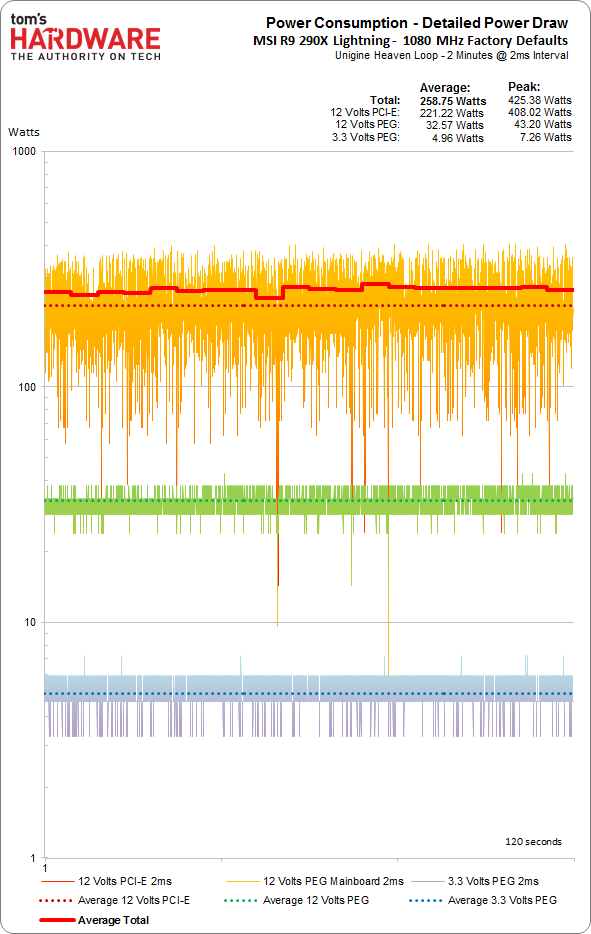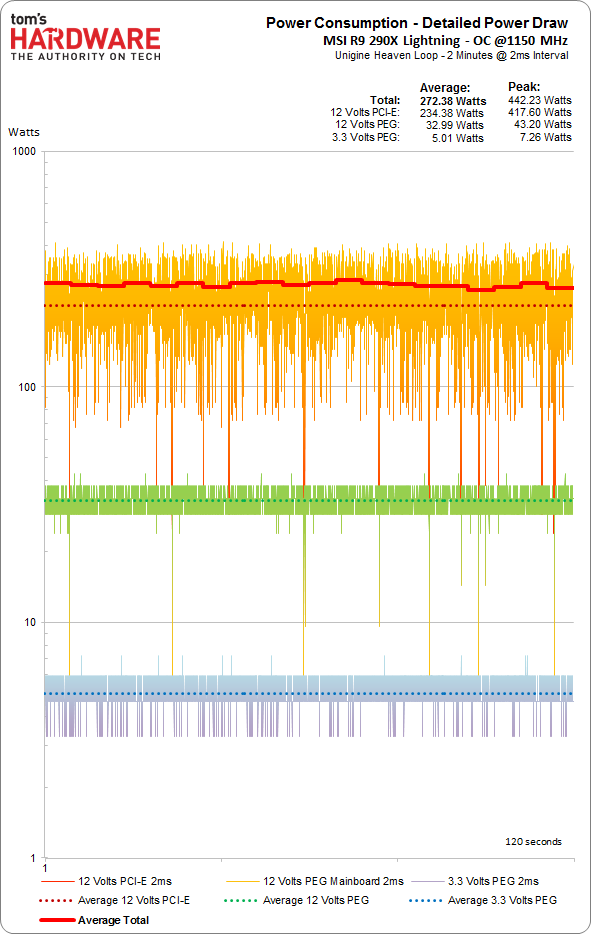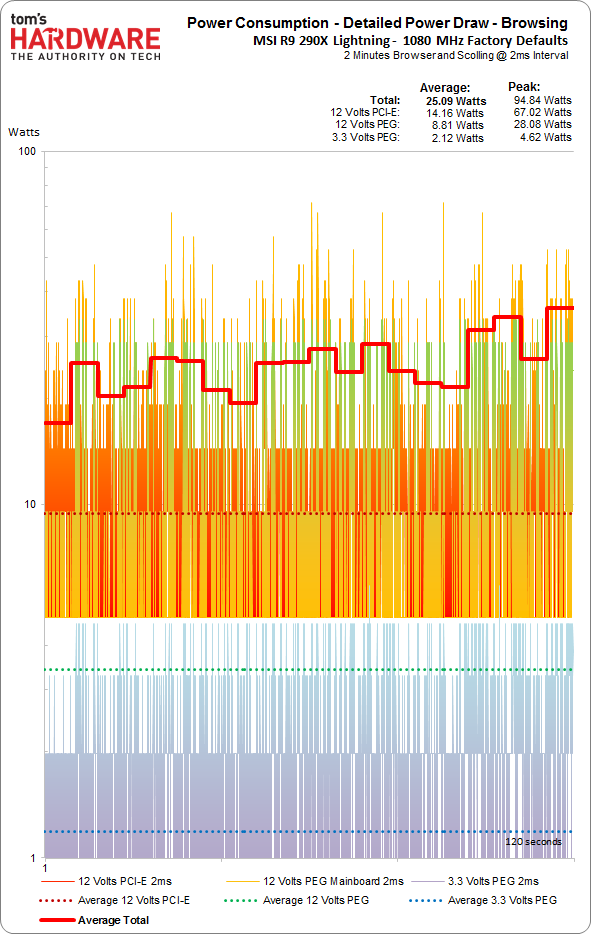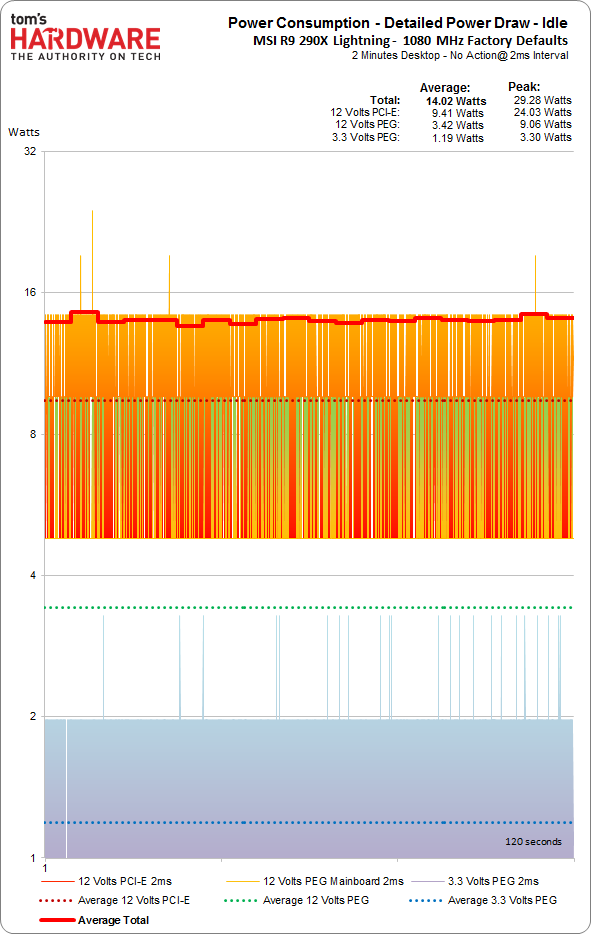MSI R9 290X Lightning Review: The Right Way To Cool Hawaii
Judging from the R9 290X Lightning's hefty build, it takes a lot of metal to cool the Hawaii GPU properly. But what does this massive card give you aside from sharp looks? How about impressive acoustics? Is its $750 price tag worth the premium experience?
Power Draw: Gaming, Web Browsing, And Idle
Measuring the Power Draw
The following diagrams contain a text header, which is followed by the actual measurement curves. In that header, you'll find the average and peak power draw on all three rails, along with the sum of those averages, giving us the total average and peak power consumption.
Total peak wattage is not simply the sum of the three individual peaks, but rather the total peak wattage observed within the 120-second sample window. That makes more sense than adding the peak wattages together, since it's unlikely that all three max out at the same moment.
Power Consumption during Gaming, With and Without Overclocking
These diagrams employ a logarithmic scale. The thick red line represents average total power draw at a time resolution of six seconds.
When the card is overclocked from 1080 to 1150 MHz, an increase of 6.5 percent, graphics performance increases by approximately four percent. The power draw increases by a mere five percent, showing that Power Tune does a good job. Unfortunately, in order to increase this card's GPU voltage, you have to register with MSI for a special license. This isn't given out freely; only professional overclockers can get their hands on it.
Power Draw During Internet Surfing
People don’t spend all of their time gaming; typically, much more is spent browsing the Web. We simulate this workload with a static version of our home page, scrolling all the way down and back up again. While scrolling does make use of hardware acceleration, the power draw for that is quite benign.
Power Draw at Idle
Many people leave their PCs on all the time, making the power consumption of components at idle quite important. Measuring draw from the wall doesn't cut it if we want to isolate the graphics card, since there's no way to reliably factor out the rest of the platform.
Our state-of-the-art test equipment shows that this graphics card only draws 14.02 W at idle, which is less than our previous generation of lab instruments indicated:
Get Tom's Hardware's best news and in-depth reviews, straight to your inbox.
We found one interesting detail. Sometimes, power consumption at the motherboard slot drops to zero, and sometimes power use through the auxiliary power cables does the same thing. Obviously, this never happens at the same time. However, the phenomenon still surprised us.
Current page: Power Draw: Gaming, Web Browsing, And Idle
Prev Page Power Draw: Test System And Methods Next Page Temperature And Sound Level
Igor Wallossek wrote a wide variety of hardware articles for Tom's Hardware, with a strong focus on technical analysis and in-depth reviews. His contributions have spanned a broad spectrum of PC components, including GPUs, CPUs, workstations, and PC builds. His insightful articles provide readers with detailed knowledge to make informed decisions in the ever-evolving tech landscape
-
blackmagnum If it costs 750 bucks, it should come with water-cooling. Why the need to slap on a pound of metal to cool it if there was a more customer friendly way?Reply -
solix Unless I am mistaken you burn 3 slots with this guy. For how close this is to the Tri-x in thermals and acoustics, but with the loss of a slot and the added price, meh. Tri-x still seems like the best value proposition.Reply -
CaptainTom I just want to point out how silly the 780 Ti is priced. People, this card trades blows with the 780 Ti while giving you an extra GB of VRAM. It should cost at least as much as the 780 Ti. Or better yet, the other way around! ;)Reply -
AndrewJacksonZA ReplyUnfortunately, in order to increase this card's GPU voltage, you have to register with MSI for a special license. This isn't given out freely; only professional overclockers can get their hands on it.
Whoa, wait, what??? -
dscudella As of my post, the pricing on Newegg for the mentioned cards:Reply
MSI 290x Lightning $699.99 + $4.99 shipping
Sapphire 290x Tri-X OC $649.99Sapphire 290x Tri-X $639.99Gigabyte 290x Windforce $579.99 ($549.99 after rebate)
This makes the Lightning $125 ($155 after rebate) more expensive than the Windforce. MSI is really stretching the price here. -
zzzaac $899 or 841 USD where i'm from for this card. Got to admit though, 3 slot cards are really unappealing for me.Reply
Got to agree that the Tri-X seems a better value proposition
-
cats_Paw A bit useless review:Reply
The main aspect of a GPU and its most important job is to make games run smooth.
In this review there is only a Performance ratio chart. This does not give the important data at all.
I dont care if that GPU has 80 or 85 FPS in farcry3, but I Do care if it has 25 or 30 on more demanding games/settings.
Finally, this card seems like itsmissing its purpouse a bit.
It has a huge heatsink, but dosent actually run cool or quiet.
It has an OC that is decent but dosent increase performance that much.
You could water cool that GPU for a similar price and get better performance in every aspect as long as you are willing to have a loop in your PC.
-
redgarl Where is your review of the Powercolor PCS+ R290x...? From all the review I have seen, not only they are cheaper, but perform better I from what I am seeing, smaller.Reply -
ubercake That "Certificate of Quality and Stability" is humorous...Reply
"I hereby declare this video card to be of the utmost quality and thereby further and henceforth declare this same electronic device to be 101% stable to the fullest of my capabilities to determine it as such. Sincerely, Your Mom".
Definitely something to frame and hang on your wall above the monitor. -
ewok93 I feel like it would be much more cost effective to go with water cooling, it would definitely be much lighter. I may be wrong, though, as that heatsink is pretty freaking massive. It just seems like past a certain point, air cooling can only do so much, and can only take up so much space.Reply
If you're just going for overkill, I want to see one of these with phase change cooling. It can't cost that much more, can it?



